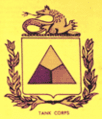Knights of the Armor Force


“We Forge the Thunderbolt”

Welcome to the Gen George Patton Room
We dedicate this room to the memory of General George S. Patton Jr. and to his work for the Armor Force. George Patton was commissioned into the Army in 1909. He later participated in the unsuccessful attempt to capture Pancho Villa in 1916-17. In World War I, he was one of the first officers assigned to the new Army Tank Corps in France. He started the Army's first tank school and saw action in France. Patton stated, "Tanks are a new and special weapon-newer than, as special, and certainly as valuable as the airplane." After the war, he continued to be a strong advocate of the use of tanks in the United States Army.
In World War II, Patton commanded corps and armies in North Africa, Sicily, and the European Theater of Operations. Near the end of the Sicilian campaign, Patton jeopardized his career by slapping a soldier recuperating from battle fatigue at a hospital; Patton considered him a coward. The well-publicized incident caused General Dwight D. Eisenhower to relieve him of command. Thus, instead of playing a major part in the Normandy Landings and Operation Overlord, he was relegated to acting as a decoy in Operation Quicksilver. However, he was later given command of the soon-to-be-famous U.S. Third Army and ably led it in breaking out of the hedgerows of Normandy and across France. A surprise German offensive known as the Battle of the Bulge resulted in American units being surrounded in the town of Bastogne, Belgium, but Patton rapidly disengaged his army from fighting in another sector and moved it over 100 miles in 48 hours to relieve the siege during the bitterly cold winter of 1944.
Patton often got into trouble. In addition to the slapping incident, toward the end of the war, he voiced his mistrust of the Soviet Union and his desire to fight them. However, he was greeted as a returning hero when he returned for a visit to the United States in June 1945. The most famous Knight of the Armor Force passed away on 21 December 1945 after an automobile accident in Germany.